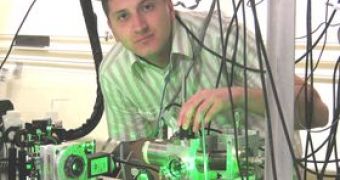Newton's third law of motion postulates that any force acting upon a body will produce an opposing force of the same strength acting against the first one. This seems not to be entirely true, as quantum mechanics presents an interesting phenomenon called the Aharonov-Bohm effect.
Also known as the Ehrenberg-Siday-Aharonov-Bohm effect, due to the fact that Ehrenberg and Siday discovered it a decade before the Aharonov-Bohm team, it occurs when electrons passing through regions of space experience a change in phase, though there are no magnetic or electric fields interacting with them. It has been observed only in electrons traveling through regions where the magnetic field is zero, but it is generally believed that this effect should also be present in electric fields with zero potential.
However, Herman Batelaan's experiment has nothing to do with proving what generates this effect; he wanted to demonstrate that electrons react without the input of any force. The results of the experiment that took place at the University of Nebraska-Lincoln, clearly demonstrate that the AB effect is not triggered by any forces.
According to Batelaan, though the effect is well known for more than half a century since it has been first detected, nobody ever bothered to actually determine if there are any forces acting in those regions of space. His experiment showed for the first time the lack of forces, as formerly predicted by scientists.
The experimental testing of the AB effect consists of controlling electrons by using distant electromagnetic fields but these experiments are well understood so Batelaan designed one that measures the forces acting on a needle while hitting it with a pulsing laser. If there were any forces present, then there would be certain delays or early arrivals of the electrons pulsing from the source. But these delays haven't been observed, thus there are no forces acting on the electrons in the AB effect, though something clearly produces changes in the electrons phase.
However, though this represents fundamental aspects of the quantum mechanics, the results can't be used to create applications since the experiment does not prove useful on a practical level. The rapid development of technology and the speed at which devices get reduced in size will require understanding the role of interaction between quantum mechanics and electromagnetic fields.

 14 DAY TRIAL //
14 DAY TRIAL //